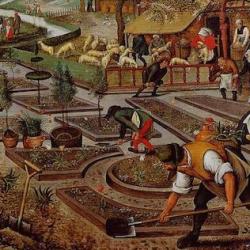A discussion this morning concerning the economic impact of the gospel got me to thinking about Byzantium. What kind of economic system did the Eastern Christian empire, with its centralized state and luxurious capital, have?
I found some help in Angeliki Laiou and Cecile Morrison’s The Byzantine Economy. I include some quotations below, particularly on the question of the state regulation of Byzantium’s fabled markets:
“State legislation regarding exports served to create a distinction between one region, the Byzantine Empire, on the one hand, and, on the other, the foreign or international market. While there were no import prohibitions, a number of prohibitions applied to exports. The category of goods called ‘forbidden’ (kekolymena) included important alimentary products (cereals, salt, wine, olive oil, fish sauce), precious metals, especially gold, strategic commodities like iron and arms, and silks of very high quality. The prohibitions were motivated not only by economic reasons but also by political ones, but they still had economic effects. Thus, while the legislation was sometimes breached, and began to become attenuated by the early tenth century, it nevertheless signals the concept, as well as the reality, of a domestic market, where goods traveled freely, as opposed to the foreign market which was subject to controls. In that sense, the state created a ‘national’ market.”
“Constantinople, with its large population, was also a great center of consumer demand for alimentary products and raw materials. In the case of alimentary products, the state had a particular interest in keeping the population adequately supplied at accessible prices, for the fear of rioting was never far away. Hence the protection of the consumer through the regulation, for example, of a maximum profit on bread, items sold in general stories, and fish. Hence also the fact of a limited but real interference of the state in the grain trade. The available evidence is ambiguous. One supposes that in the eighth century the grain trade was regulated, although not entirely. In the ninth-tenth centuries, there seems to be a mixture of government-regulated and private ships carrying grain to Constantinople. But the grain trade was not organized by the state, nor was the price of grain enteriny Constantinople regulated, which is why there were short-term fluctations in its price. The state did intervene by ensuring supplies: for example, requiring the owners of grain ships in Bithynia to transport, once a year, grain for the imperial treasury. In times of crisis, when there was a scarcity of grain, the emperors would have grain brought in from other parts of the Empire. And they would certainly open the imperial warehouses to distribute grain and keep the price down. This, as well as imperial legislation which aimed at preventing stockpiling and profiteering, doubtless had an influence on price formation. But it is important to note that as far as we know this interference was limited to Constantinople, and did not constitute true regulations.”
“In Constantinople, according to the Book of the Prefect , the state imposed maximum profit rates on the sale of some commodities or on some economic activities: the retail sale of food, the profit on the resale of Bulgarian commodities, the profit realized by rich silk merchants who resold to poorer artisans are specifically mentioned, but it is possible that maximum profits were imposed on other translations as well. The government certainly did not fix procies, since there is no evidence that the price of commodities entering Constantiniple was in any way controlled. Fixing the profit margins, however, apart from its impact on the final price, also affects the way merchants conduct their business: since they cannot maximize profits by buying cheap and selling dear, they have to maximize turnover and keep their capital costs low . . . . There is no evidence of regulated profit rates outside Constantinople, nor do they seem to apply after the tenth century.”
“Government efforts to prevent the accumulation of resources and economic activities in the hands of individuals is, by contrast, visible everywhere . . . . Among other things, the regulations strictly delineated the activities of each guilt to ensure that none could encroach upon the activities of another. Thus, both vertical and horizontal integration were impossible, and so was the creation of large enterprises that might control the manufacturing or trade of particular commodities.”
After a great famine in the early 10th century, there was a period of massive land sales. Emperor Romanos I Lekapenos (920-44) issued a law attempting to reverse the new distribution of land. One part of the law envisioned a “case in which the peasant had been forced by need to sell at a price lower than half the ‘justice value’ of the land. In such a case, the buyer lost the land, with no compensation at all for the price he had paid. This is a highly expansive interpretation of the law regarding the ‘excessive damage’ done to the seller who sells, albeit with his full knowledge and uncoerced consent, at an excessively low price . . . .”
Prices were determined by free exchanges between competent persons. ”The just price was not legislated: even the fiscal price of land was established through a mixture of fiscal estimation and the ‘customs of the area,’ that is, the market value of the land. Just profit, however, meaning the margin which could be reached through negotiation, was another matter. Already in the early ninth century the patriarch Nikephoros of Constantinople had stated that the profit of the merchant was ‘just’ if it did not exceed 10 per cent. The regulations in the Book of the Prefect spoke of ‘unreasonable profit,’ and established ‘just profit’ margins for a number of commodities and transactions.” In the tenth century, laws concerning the sale of land by the poor to the powerful were applied to the building trade, with the result that “all contracts in which the builder agreed to a wage below the just wage were invalid; there is a clause in the relevant ordinance that suggests that the same held true for all commercial regulations, which would be a truly immense extension of the original legislation.” In short, “what happened in the period through the tenth century i
s that the state placed limits on the results of free negotiation. It is a system static in conception, in which individual economic action is limited by the needs of society as a whole.”














